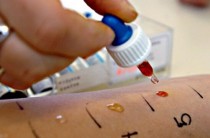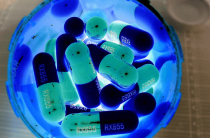Allergy often has skin manifestations, it mainly occurs when food, cosmetics or drugs are intolerant. The use of ointments for allergies allows you to eliminate adverse symptoms that develop as a result of the body's hypersensitivity to certain components.
Creams and ointments for allergies, compared with drugs in injections or tablets, although they contain the same active ingredients, have a significant advantage. When using drugs in the form for local external use, the risk of side effects is significantly lower. It often happens that a person develops only skin manifestations of an allergy, without the development of other forms of an allergic reaction. This group of manifestations is called dermatoses. This means that the risks of therapy with systemic drugs far outweigh their benefits in the treatment of dermatitis.
It should also be noted that dermatitis may have a slight degree of localization, for example, minor rashes on the elbows. In this case, there is no need for treatment with systemic drugs. Compliance with preventive measures, as well as the use of external ointments to relieve symptoms, will be quite enough.
Allergy skin symptoms
Allergy symptoms that have skin manifestations represent an extensive symptomatic group. It is characterized by various manifestations:
- Small bubbles filled with liquid content. When combed, they are covered with a crust of yellow-brown color;
- Large blisters can also occur with an external allergic reaction.
- Give the patient a lot of inconvenience;
- Redness of the skin. The most common manifestation of dermatitis. Reddened areas of the skin may be covered with small vesicles with serous contents;
- Changes in the structure and color of the skin: blanching of the skin, peeling of the skin;
- Unpleasant sensations, manifested by itching, burning sensation, tingling;
- Swelling of the skin
Skin allergy treatment
At first glance, skin allergies But this is not so, if the symptoms of skin manifestations are left for a considerable time, then this can cause a variety of infections, skin defects, and the appearance of deep wounds. It is also necessary to take into account that allergic manifestations are often accompanied by severe itching, which forces the patient to comb the localization of dermatitis, which further enhances the already unfavorable symptoms.
The manifestations of dermatitis, which are overdried areas of the skin or other easily traumatized violations of the normal skin, are easy ways for parasites and microbes to enter the body.
Hormonal ointments for allergies
These drugs are called hormonal because they contain either synthetic glucocorticoid hormones or their analogues that have similar effects. These substances have an extensive effect on allergy symptoms. Glucocorticoids have the ability to suppress the production of antibodies, as well as prevent their release by immune cells. Without antibodies, the allergen is not able to affect the body. In addition, they are able to relieve skin itching, as well as have anti-inflammatory and anti-edematous effects, which also help to neutralize the manifestation of allergic reactions.
The powerful effect on immune suppression that hormonal ointments have makes their long-term use undesirable. Too frequent use on large areas of the skin causes a weakening of skin immunity, which leads to the appearance of areas of infection, a deterioration in the regenerative abilities of the skin, and its coarsening.
Betamethasone
The main active ingredient of this ointment for skin allergies is a synthetic substance with increased anti-inflammatory and allergy-reducing activity. According to these indicators, it is several tens of times superior to natural corticosteroids produced by the adrenal cortex. Also, betamethasone effectively eliminates itching, thereby preventing further scratching of the areas of the allergic reaction. Betamethasone has an effect on mast cell membranes, which remain stable under its influence and do not release histamine. Betamethasone also inhibits the production of substances necessary for the development of allergic reactions. Inhibition of the production of B and T lymphocytes prevents the emergence of new antibodies, thereby inhibiting the development of allergic reactions. The removal of edema under the influence of betamethasone is due to its effect on vascular cells, as a result of which the vascular tissue begins to narrow, removing puffiness.
Prednisolone
This substance with great efficiency inhibits the formation of basophils and reduces the number of existing ones. Basophils are cells belonging to the immune system that contain histamine, serotonin and leukotreins - those substances that are necessary for the onset of allergy symptoms. Its effectiveness in dermatitis is due to the fact that it interferes with the transformation of the upper layers of the epidermis into areas of allergic lesions.
It should be noted that prednisolone relatively easily penetrates through the capillaries into the circulatory system. According to this indicator, it is the most powerful hormonal drug for systemic use. Biological transformations and the final metabolism of prednisolone occurs in the liver. This ointment for skin allergies is the safest.
Hydrocortisone
This substance is a direct analogue of the hydrocortisone of the human body. It has a powerful anti-allergic effect, relieves swelling and inflammation. It is able to suppress the flow of serotonin, histamine and leukotrein from eosinophils into the blood, due to which the chain allergic reaction is interrupted.
Hormonal ointments differ in strength of influence, therefore, in each case, the use of the ointment is prescribed by a doctor. The choice of dosage forms: cream, gel and ointment also depends on the nature of allergic skin reactions. In inflammatory and other skin processes caused by a viral or microbial infection, as well as parasitic influence, the use of corticosteroid ointments is prohibited.
Hormonal ointments are drugs against allergies with a powerful, targeted action. Basically, they are used at the beginning of an allergic reaction, when it is necessary to relieve acute symptoms of skin manifestations. Corticosteroid drugs have a diverse effect on various manifestations of allergic reactions, due to which the chains of allergic reactions are immediately interrupted in all areas. Corticosteroid preparations for external use in the shortest possible time eliminate symptoms such as itching, burning, peeling, redness, inflammation, swelling.
Non-hormonal ointments for skin allergies
Non-hormonal agents for external use include a wide variety of substances with the same diverse effect, which include substances of a non-corticosteroid structure. They are used to suppress histamine, reduce itching and flaking, accelerate wound healing, and moisturize the skin. Among them, there are also effective homeopathic remedies.
Bepantent
Ointment based on bepanthen stimulates the healing of the skin, and also promotes hydration. It is also used to treat dermatitis, since their manifestations are often accompanied by drying, irritation and the appearance of wounds. Removes redness, makes the skin soft and soothes the skin, and also has a rejuvenating effect. The substance has a high degree of safety, therefore it is suitable for use.
Antibacterial drugs can also be used if there is a process of infection of the skin, through the resulting wounds or cracks. In this case, it is necessary to carefully monitor drug interactions that may develop against the background of the use of other anti-allergic drugs.
Gistan
A preparation based on natural plant extracts that have anti-allergic and anti-inflammatory properties. These substances block the production of histamine, which is responsible for the development of allergic reactions.
Prevention of dermatitis
The most important thing that can be done to prevent dermatitis is to eliminate the source of the allergy. If this cannot be done, then it is desirable to minimize the interaction with the substance provocateur of allergies. The effect of the allergen on the body is dose-dependent. This means that the more allergens affect the patient's body, the more extensive is the allergenic reaction.
The patient can engage in effective prevention only if he is familiar with the causes of dermatitis:
- Medicinal preparations for external use. So, for example, allergies often occur on sunscreens, antibacterial ointments, etc.;
- Dermatitis can develop with contact forms of allergies that develop as a result of interaction with certain fabrics of clothing and underwear. Basically, an allergic reaction is caused by clothing consisting of synthetic fabrics and wool.
- It is necessary to use clothes made from natural fabrics: cotton, linen, hemp, silk, etc.
- Skin manifestations of allergies can occur on household chemicals, cosmetics and perfumes. Numerous substances that make up this product have varying degrees of irritating effect on the skin. When choosing these funds, it is necessary first of all to pay attention to their hypoallergenicity;
- Toxic interaction with the skin during hazardous production. Pay attention to whether security measures are sufficiently observed, and also use protective ammunition without fail;
- Avoid biting stinging insects;
- During pregnancy and feeding, follow a hypoallergenic diet so as not to provoke the development of an allergic reaction in a child;
- Breastfeeding is a mandatory preventive measure against the development of allergies and many other diseases in a newborn;
- Do not expose your skin to extreme temperatures, in particular avoid hypothermia and prolonged exposure to the scorching sun;
We remind you that the treatment of allergies should be carried out exclusively by competent specialists who prescribe specific drugs on the basis of a comprehensive and complete medical examination. Self-medication carries huge risks and is fraught with dangerous consequences. We are categorically against an unskilled approach to the treatment of any disease or disorder.















